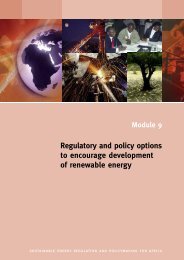Increasing access to energy services in rural areas - REEEP ...
Increasing access to energy services in rural areas - REEEP ...
Increasing access to energy services in rural areas - REEEP ...
You also want an ePaper? Increase the reach of your titles
YUMPU automatically turns print PDFs into web optimized ePapers that Google loves.
MODULE 10: INCREASING ACCESS TO ENERGY SERVICES IN RURAL AREAS<br />
page 10.83<br />
1. BACKGROUND<br />
Access <strong>to</strong> electricity <strong>in</strong> the <strong>rural</strong> <strong>areas</strong> of Zambia is as low as 2 per cent. In order<br />
<strong>to</strong> address this situation and <strong>in</strong>crease <strong>access</strong> <strong>to</strong> electricity and reduce poverty, the<br />
Government of the Republic of Zambia (GRZ) <strong>in</strong>corporated the <strong>in</strong>stallation of pho<strong>to</strong>voltaic<br />
(PV) solar systems <strong>in</strong> the <strong>rural</strong> electrification programme. Zambia has an<br />
average of 2000-3000 hours of sunsh<strong>in</strong>e per year. In order <strong>to</strong> accelerate the <strong>rural</strong><br />
electrification programme, the Government established the Rural Electrification<br />
Authority <strong>in</strong> 2003 follow<strong>in</strong>g the promulgation of the Rural Electrification Act (2003).<br />
In 1998, GRZ <strong>in</strong>itiated a pilot project called “Provid<strong>in</strong>g Electricity Services us<strong>in</strong>g<br />
Pho<strong>to</strong>voltaic Systems through Energy Service Companies <strong>in</strong> Rural Areas of<br />
Zambia” also known as “The Zambia PV-ESCO project”. The project was undertaken<br />
by the M<strong>in</strong>istry of Energy and Water Development (MEWD), the Swedish<br />
International Development Agency (Sida) and the S<strong>to</strong>ckholm Environment Institute<br />
(SEI).<br />
The ma<strong>in</strong> objective of this project was <strong>to</strong> identify the framework and conditions<br />
necessary <strong>to</strong> successfully provide electricity <strong>services</strong> <strong>to</strong> <strong>rural</strong> <strong>areas</strong> through <strong>rural</strong>based<br />
<strong>energy</strong> service companies (ESCOs). The project would provide policy-makers<br />
and planners <strong>in</strong> Zambia with the <strong>in</strong>formation required <strong>to</strong> enable private sec<strong>to</strong>r<br />
<strong>to</strong> participate <strong>in</strong> <strong>rural</strong> electrification us<strong>in</strong>g a fee-for-service approach.<br />
This case study describes the Zambia PV-ESCOs pilot project, exam<strong>in</strong>es its first<br />
six years of operation and highlights lessons learnt.<br />
2. PROJECT DESCRIPTION<br />
The project design was <strong>in</strong>fluenced by experiences <strong>in</strong> other parts of the world where<br />
PV systems have proved <strong>to</strong>o expensive and unsusta<strong>in</strong>able for the <strong>rural</strong> poor.<br />
The Zambia PV-ESCOs pilot project was <strong>in</strong>itiated <strong>in</strong> June 1998 by the MEWD with<br />
f<strong>in</strong>ancial assistance from Sida and the technical assistance from SEI. The strategy<br />
was <strong>to</strong> provide <strong>energy</strong> <strong>services</strong> through already exist<strong>in</strong>g and viable <strong>rural</strong>-based<br />
companies. These companies would <strong>in</strong>stall solar-based systems <strong>in</strong> domestic<br />
houses and other commercial build<strong>in</strong>gs and provide the necessary ma<strong>in</strong>tenance<br />
and technical support. The clients would not purchase the PV systems but rather<br />
pay a monthly rental for the use of the PV system and the service provided by<br />
the service company.










